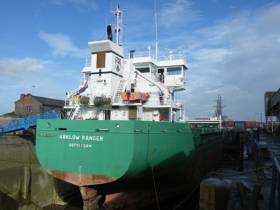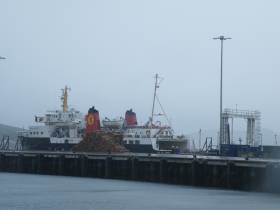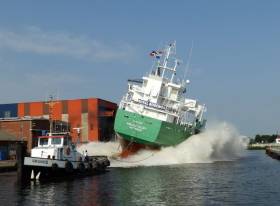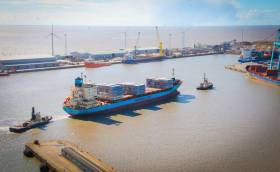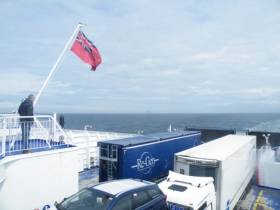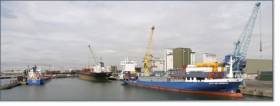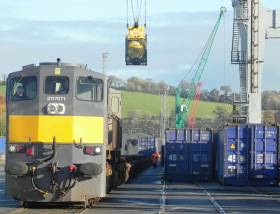Displaying items by tag: Ports & Shipping news
Cork Dockyard Receives Former Dublin Dry Dock Business
#CorkDockyard – Cork Dockyard, now the only large dry-dock in the Republic following the closure of the Dublin facility earlier this year, is today to receive a vessel of a client that used the capital’s last dry-dock, writes Jehan Ashmore.
The arrival of Arklow Rose to Cork Dockyard saw the 2,999 gross tonnage general cargoship enter dry-dock at 11 o’clock this monring. Arklow Shipping, were one of the major clients of the Dublin Graving Docks that generated around €2.5m annually and handed around 20 ships.
The Dutch flagged ship is one of oldest in the Arklow Shipping fleet, dating to 2002, while the latest newbuild, Arklow Valley was launched in the Netherlands only last month.
The final ever ship to use the Dublin shiprepair and conversion facility was Arklow Fame in April. This vessel of a different class, however has almost the same hull dimensions of Arklow Rose, of almost 90m long, a beam of around 14.5m and draft approximately 7.20m.
As an island nation, the loss of the strategic Dublin Graving Docks (to be in-filled for Dublin Port’s €227m Alexandra Basin Redevelopment project), reduces the ability to cater for certain sized vessels. The capital’s dry-dock (220.00m long) could cater for larger vessels than Cork Dockyard’s (165.50m long). Asides shiprepair, conversion, the Rushbrooke yard (formerly Verolme Cork Dockyard) also carries out marine engineering and fabrication.
Another factor is the graving dock entrance width at Cork Dockyard, which is also narrower than what the Dublin yard offered. This led to the former ferry operator, Swansea-Cork Ferries 15,127 gross tonnage route ship, Superferry having to use the Dublin facility instead. The 137m long ferry had a beam of 23.4m while the graving dock entrance at Cork Dockyard was only 21.3m.
It should be noted this measurement is exactly the same of the breadth extreme of ASL’s ‘S’ class bulkers, for example, Arklow Meadow. The South Korean built bulker which operates deepsea trading was accommodated in the Dublin dry-dock, that was completed in 1957.
An adjacent much older graving dock dating to 1860 and only in-filled in 2008 is where there are plans for the site to be excavated!... for story and photo including the bulker dry-docked click here.
Former US Army Landing Craft Transports Generators to Aran Islands
#AranCargoship - The cargsoship that transported generators to restore electricity supply to two of the Aran Islands this week, Afloat has identified as a former US Army landing craft vessel, writes Jehan Ashmore.
The generators were craned off the MV Chateau-Thierry, which among its services, Lasta Mara Teo operates a roll on / roll-off service from Rossaveel, Co. Galway.
As previously reported the subsea cable fault left almost 400 residents of Inis Meáin and Inis Oírr without power for four days, was restored at the beginning of this week. Work, however to repair the subsea cable could take up to four weeks.
The Galway registered twin-screw, Chateau-Thierry operates a Rossaveal-Aran Islands service that is mostly involved in trasnporting large cargoes, maintly trucks, excavators, heavy plant and machinery.
A prime example of moving heavy machinery, were those used in the construction to build the outer harbour of Kilronan (Cill Rónáin) on the main island of Inishmore. This was to improve ferry access to and from the mainland. During construction, vehicles were driven off the Chateau-Thierry, which is equipped with ramps that were lowered onto the beach beside Kilronan Pier.
It was during a visit to Inishmore in June, 2009, that asides observing the busy ferry traffic, trawler Iolair and coaster Stenland were also alongside Kilronan Pier. The former Norwegian vessel that traded as Beth Anja, was then tramping around carrying cargoes along the mid-west coast, between Galway and Westport. It was from the Co. Mayo port was where among the cargoes included building materials loaded for Clare Island.
Also on that Aran occasion, another Norwegian connection was that of the former Hurtigruten coastal cruise cargo-ferry, Midnatsol. The vessel converted to cruiseship, National Geographic Explorer was anchored off Kilronan Harbour. Cruise-goers took to 6,471 tonnes vessel's fleet of zodiacs to reach the island harbour.
As for the works of the new outer pier at Kilronan, this required 77,000 tonnes of large natural stone blocks sourced from Connemara, to protect the breakwater from erosion. The new harbour, twice the area in size of Croke Park, had been voted in 2012 by the public as the Best Engineering Project of the Year.
Also engaged in the project was Irish Dredging, part of the Dutch owned Boskalis Group, which recently completed removal of spoil from Dublin Port and out to dumping grounds in the bay.
Port Snapshot: Campbeltown's Kintyre Links Continue With Ireland As Cruise Tallship Calls
#PortSnapShot – Campbeltown, Scotland, almost at the tip of the Mull of Kintyre and a mere 19 km/12 miles from Northern Ireland, is where the impressive cruise tallship, Sea Cloud II is visiting today, writes Jehan Ashmore.
The 5-star ultra-luxury Sea Cloud II having made an overnight call to Dublin Port that ended yesterday. This evening she heads into the North Channel on the short passage to Belfast Harbour.
Guests of the Sea Cloud Cruises ‘windjammer’, is docked alongside the New Pier at Caledonian MacBrayne’s (CalMac) ferry terminal. This season marks the first year of the ‘permanent’ designated Ardrossan-Campbeltown service, following a three-year summer operated pilot service as part of CalMac's extensive route network of the Clyde and Western Isles.
Sea Cloud II's presents a majestic appearance given her three masts in which the main mast towers 57m /187ft, however, a 3,849 gross tonnage is not much larger than the local CalMac ferry, Isle of Arran of 3,296 respectively. The thrice-weekly operated ferry is not today in port which is home to a trawler fleet.
Asides the seasonal Forth of Clyde ferry service to and from Ardrossan, Campbeltown’s second ferry link consolidates the Irish connection. At the town’s marina is where the ‘passenger’-only RIB ferry to Ballycastle, Co. Antrim is operated by Kintyre Express They also have a Ballycastle service to Port Ellen on Islay.
Prior to this Ireland-Scotland link, was the Argyle & Antrim Steamship Co. that also ran between Campbeltown and Ballycastle. The short-lived three-year (1997-2000) summer-only route was served by Claymore, having been sold by CalMac to the company, a subsidiary of Sea Containers (Scotland) Ltd. In winter she acted as overhaul relief vessel for CalMac when under charter.
On a notable occasion, Claymore left Scottish waters, when chartered during the visit of USS John F. Kennedy (CV-67) as the giant 82,000 tonnes aircraft carrier anchored off Dun Laoghaire Harbour, just over two decades in July 1996. A public lottery was held for thousands to visit the Dublin Bay naval visitor by boarding Claymore and other ‘tender’ vessels. This was during the backdrop of Jean Kennedy-Smith's tenure as US Ambassador to Ireland, in the early days of the northern 'peace process'.
Asides the Ardrossan ferry, Campbeltown exports round timber (logs) as seen above at the New Pier Quay, where Sea Cloud II currently occupies this berth. Short-sea coasters on occasions call to the harbour to load timber to Irish ports, among them Rosslare Harbour as previously reported on Afloat.ie.
Last but not least, P.S. Waverley, the world’s last sea-going paddle-steamer, in which among her owners included Caledonian MacBrayne until withdrawn in 1973. Two years later she was sold for preservation and is less than two months to celebrating her 70th anniversary, having been launched on the Clyde at a Glasgow yard in 1946.
She is operated by Waverley Steam Navigation Co. Ltd. During seven decades the veteran vessel has carried over 5 million passengers from over 60 ports around the UK. This summer she made an Antrim Coast Cruise off Redbay. Stormforce RIBS used by Kintyre Express are manufactured by Red Bay Boats in Cushendall that overlooks the bay.
Waverley made her Irish debut in 1984 along Leinster's eastern seaboard. Over subsequent calls, she has visited Dundalk, Dublin, Dun Laoghaire, Wicklow, Arklow and as far south to Rosslare Harbour. The paddle-steamer excursions also included transitting Dalkey Sound.
Shipping Review: Arklow’s Third ‘Valley’, Maersk’s Larger Ship, Exporters On Brexit & More
#ShippingReview - Jehan Ashmore reviews the shipping scene from recent weeks.
Arklow Shipping’s latest 5,150dwat cargoship newbuild built by Royal Bodewes, a Dutch yard in north-east Netherlands, launched Arklow Valley with a sideway splash into the waterway.
A Wicklow Port regular, cargoship Burhou I, has been involved in assisting the redevelopment of a CalMac ferryport, on the Isle of Arran, Forth of Clyde.
Maersk subsidiary Seago Line introduced larger replacement containership, Independent Accord to its recently created Spain-UK-Ireland ‘feeder’ service calling at Dublin Port.
An overwhelming majority of Irish Exporters Association members, 92% believe the decision by UK to leave EU will have a harmful effect on their business.
One of three ICG container divisions, EUCON operating Ireland-France/Belgium 'feeder' services, increased their 45ft unit capacity. The 300 units made in China will be introduced in September.
#LargerShip - Maersk subsidiary Seago Line has introduced a larger capacity load-on /load-off (lo-lo) containership to its recently created feeder service calling at Dublin Port, writes Jehan Ashmore.
The Independent Accord (2007/20,995gt) operates the new container route between Algeciras-Liverpool-Dublin that began in April. The vessel has a 1,579TEU which is more than her predecessor, Antwerp with 1,058TEU that launched the service.
This morning, Independent Accord is offshore of Land’s End, Cornwall, bound for Liverpool. The UK north-west port until April, was the first time that the Maersk Group had used the Merseyside port in over 10 years.
In addition the UK-Ireland-Spain feeder service is a first ever direct connection for Maersk/Seago to the Dublin. The next call to the capital is scheduled for this Friday, and then onward to the Spanish hubport.
The service was established to provide direct cargo connections to and from the north west of England to Ireland and onwards to the Mediterranean, providing trade links to North and West Africa. It offers a six-day transit time between Algeciras and Liverpool, with vessels arriving and departing on Wednesdays.
“We are very happy to be introducing a new vessel to the route so soon after we created this new connection to Liverpool, expanding our product portfolio for markets in the UK and Ireland”, said Seago Line General Manager for UK & Ireland, Robert Clegg.
He added “We are well placed to serve customers looking for new opportunities through a Mediterranean connection, thanks to our competitive transit times and convenient berthing windows. We are also able to offer our customers in Liverpool’s hinterland access to South European and North African markets via Seago Line as a complementary addition to our existing offer.”
Liverpool2 started handling its first containers earlier this month and will continue with a phased opening throughout the summer and full operation of Phase 1 from the autumn.
IMDO Review: Stena On Brexit, UK Shipping Calls for Free Trade, Expanded Panama Canal & More
#IMDOreview - The latest Irish Maritime Development Office (IMDO) Weekly Market Review has among the following stories as outlined below.
Irish Maritime News: Brexit: Stena Line Discuss the Impact of Brexit - As reported also on Afloat.ie, Stena Line has said it will have to assess how Brexit could impact the UK.
The Swedish company, which sails from Holyhead to Dublin, employs hundreds of workers in North Wales. A Stena Line spokesman said: "As Brexit is a completely new situation Stena Line will have to evaluate its potential impacts from a number of different perspectives.”
Brexit: UK Chamber of Shipping Calls for Free Trade Commission Assistance - In response to last week's decision by the UK to leave the European Union (EU) in the so-called "Brexit" referendum, the UK Chamber of Shipping has issued a call for the government to establish a new Free Trade Commission for the country in order to support, among other things, the country's shipping industry.
Global Maritime News: Expanded Panama Canal - The newly expanded Panama Canal is expected to boost trade between China and Latin/South America as it makes the flow of goods between the two regions easier and more efficient, a Mexican expert on Asia said.
Jose Luis Leon-Manriquez of Mexico City’s Autonomous Metropolitan University, spoke with Xinhua following the opening of the expanded canal on Sunday, with the inauguration ceremony featuring a huge Chinese container ship (COSCO Shipping Panama, Afloat adds) passing through the waterway.
For more on the above stories and other news items, click the IMDO Market Review (Week 26) here.
In addition to further dedicated coverage visit Afloat.ie's Ports & Shipping news.
Shipping Review: Reduced Exposure on Brexit, Marine Industry Awards & Port Volumes Rise
#ShippingReview - Jehan Ashmore reviews the shipping scene and of the following stories among the last fortnight.
Enterprise Ireland are to seek its clients to be less reliant on UK markets following Brexit, this is to reduce exports by about 7% over the next five years.
Bad news for Irish exporters into the UK as imports will decline as foreign products become more expensive due to weakening sterling, ratings agency Fitch has warned.
At the second annual Marine Industry Awards, held in Galway, Dr Dave Jackson of the Marine Institute was named as Marine Industry Leader for 2016.
After 15 years the European Commission, Council and Parliament have agreed on Port Regulation, a legal framework for organising port services and financial transparency for ports.
Following completion of a series of three freight train trials will enable Irish Rail to increase loads by 50%.
CSO figures reveal an increase in Irish port volumes that handled 50.7 million tonnes of goods in 2015, an increase of 3.2 million tonnes (+6.7%) when compared to 2014.
#PortTrafficStats - Irish ports handled 50.7 million tonnes of goods in 2015 according to the Central Statistics Office, an increase of 3.2 million tonnes (+6.7%) when compared to 2014.
Goods forwarded fell by 7.5% to 17.0 million tonnes in 2015, while goods received increased by 15.7% to 33.6 million tonnes over the same period.
The tonnage of goods handled rose in all traffic categories with the largest percentage increase in break bulk and all other goods (+16.7%).
The annual CSO analysis also shows that:
- The number of vessels arriving annually in Irish ports increased marginally by 0.3% to 12,242 in 2015, and the total gross tonnage of vessels rose by 3.9% to 231.7 million tonnes.
- Goods received accounted for two-thirds (66.4%) of the total tonnage of goods handled in 2015. The corresponding figure for 2014 was 61.2%. See Tables 5, 6, 7, 10, 11 and 12.
- Of the total weight of goods handled in 2015, dry bulk accounted for 31.3%, roll-on/roll-off 27.4%, liquid bulk 24.5%, lift-on/lift-off 13.8% and break bulk 2.9%.
The routes between Dublin and three UK ports – Holyhead (ro-ro), Milford Haven (liquid-bulk) and Liverpool (ro-ro and lo-lo) were the busiest routes for inward movement of goods (goods received) in 2015.
The Dublin-Holyhead and Dublin-Liverpool routes were also the busiest routes in terms of goods forwarded.
IMDO Review: Big Response to Dublin Bay Dumping, EU Agree TEN-T, UK Concerns on Brexit & More
#IMDOreview - The Irish Maritime Development Office (IMDO) latest Weekly Market Review has among the following stories below.
Irish Maritime News: The Environmental Protection Agency (EPA) received a record number of submissions in relation to Dublin Port's Dumping Plan as reported on Afloat.ie following the port's most recent application to dump spoil in Dublin Bay.
Global Maritime News: E.U Ministers Agree to Implement TEN-T - The EU transport ministers convened at the first day of the TEN-T Days in the Van Nelle Factory in Rotterdam on Tuesday of this week.They discussed the process of implementing the Trans-European Transport Network: new challenges and opportunities, new technologies and mobility patterns for passengers, as well as digitalization and automation of freight transport.
Leaders of the U.K Shipping Industry Concerned with Brexit - Members of the U.K.’s shipping community are concerned about the future of London’s role as a global centre of ship financing, brokering and insurance in the case of a British exit from the European Union.
Although the U.K. has long lost its status as the world’s top ship-owning nation, the maritime business contributes an annual $6.5 billion to the economy, with some 80% of business from abroad, according to PricewaterhouseCoopers.
For more on the above stories and other news items, click here and Afloat.ie's Ports & Shipping news here.
#LongerTrains - Irish Rail (Iarnrod Éireann) reports Multimodal, have recently completed a series of three freight train trials that will enable loads to be increased by 50%.
The final trial late last month involved a multimodal service operated from Dublin Port (North Wall) to Co. Mayo. As previously reported on Afloat the same service conducted its 1,500th train almost a year ago transporting containers.
Until this latest trail, trains on this route have been operated with a maximum of 18 wagons (36 TEUs) and this trial has now pushed the limit up to 27 wagons (54 TEUs).
The train, hauled by one of the class 201 General Motors diesels, the most powerful to operate in Ireland, was 440 metres long with a trailing load of 1,110 tonnes. The train, operated on behalf of International Warehousing & Transport of Dublin (IWT) is the longest commercial freight train to operate over the Iarnród Éireann network.
Recently a trial of an 18 wagons, 390 metres long, 1,100 tonnes pulpwood train also operated successfully between Limerick and Waterford Port.
Longer trains on the network will boost the competitiveness of rail freight to industry. The environmental benefits of rail freight would also be enhanced by operating higher capacity services – currently moving freight by rail instead of road reduces emissions up to 75% per unit, and longer trains could see emissions reduced to as little as one-tenth of the road equivalent.
Iarnród Éireann General Manger, Rail Freight, Glenn Carr said that Iarnród Éireann is currently working with existing customers as well as Freight Forwarders, Ports and the Irish Exporters Association to identify further opportunities and trends for rail freight development within the Irish and European market. In 2015, 96.4 million tonne kilometres of freight were moved by rail in Ireland.
Principle rail freight traffics on the Irish network currently include:
- Container traffic from Ballina to Waterford and Dublin Ports
- Pulpwood from Ballina and Westport to Waterford Port
- Zinc ore from Tara Mines in Navan to Dublin Port
Subject to the successful conclusion of trials, the company expects to begin operating longer freight trains from fourth quarter 2016.


























